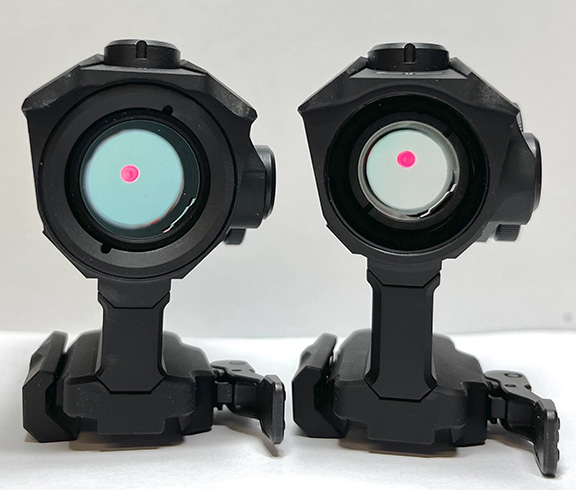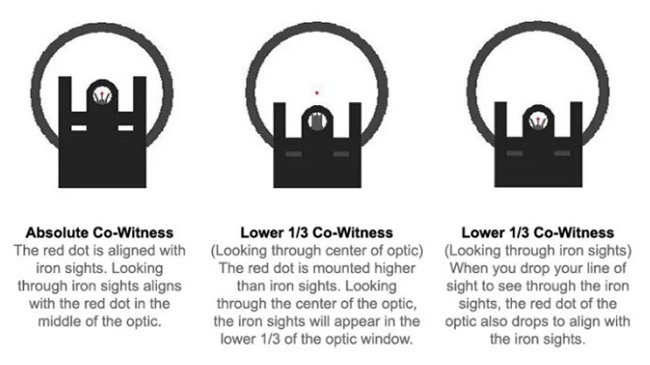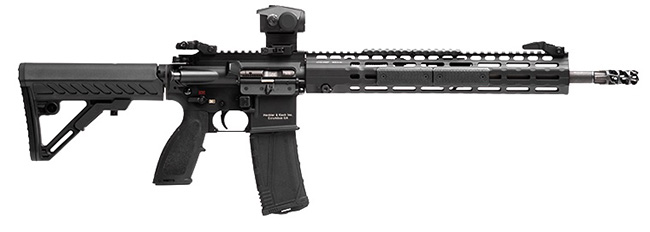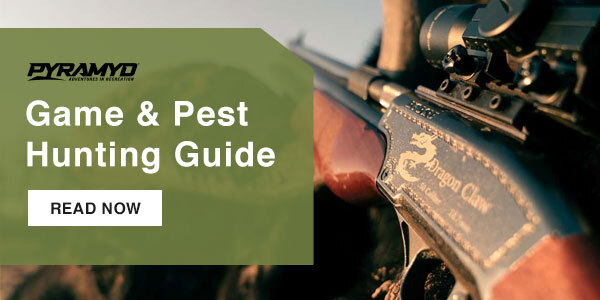Today reader Ian McKee, whose blog handle is 45Bravo, tells us about a pair of UTG dot sights.
If you’d like to write a guest post for this blog, please email me at blogger@pyramydair.com.
Take it away, Ian
Different UTG dots—different uses
by Ian McKee

Two UTG red dot sights.
This report covers:
- Similarities
- Differences
- It’s only 2mm
- What is lower third co-witness?
- Absolute co-witness
- But why you ask
- 2018R
- Other applications
- Summary
Today we will be looking at two very similar red dot sights from Leapers/UTG, and discussing why you may choose one over the other. A detailed review of these optics will be in a future blog.
Today’s subjects are the UTG ACCU-SYNC DS2018R red dot sight, and the UTG ACCU-SYNC DS2521R red dot sight.
Similarities
Both share identical construction, materials, features and quality. Such as 6061 aluminum construction, a 3 MOA (Minute Of Angle) dot size. The adjustments are 1 MOA at 100 yards. Both sights use a commonly available CR2032 battery that gives over 30,000 hours of illumination at the middle brightness setting.
Both sights are the same height, and will lower-third co-witness to the iron sights of your modern sporting rifle (more on co-witnessing in a minute).
They also share the same mounting system that is a quick-release system that securely locks the optic in place. It will not accidentally release the mount. The riser mount that raises the sight to co-witness with your sights is removable so the optic can be mounted lower to the bore if your application needs that.
The footprint of the optic is a mini-ACOG (Advanced Combat Optical Gunsight). To most of us that means it will fit a standard Picatinny rail with only one locking point of connection.
Differences
The main difference between the optics is that the 2521R (2.66 inches x 1.66 inches or 67.5mm x 42.1mm) is slightly longer and wider than the 2018R that comes in at (2.21 x 1.5 inches, 56.8mm x 39.37mm). The slight difference in width allows the 2521R to have an objective lens diameter that is 2mm larger allowing for a larger field of view. This increase in size only equates to about three-quarters of an ounce in weight.
It’s only 2mm
2mm is only 0.0787-inches but it seems to be a lot larger when you are looking through the optics.

The 0.0787-inch difference in optics diameter is apparent. The dots look huge here, but they are only 3MOA. They bloom in the camera, which makes them look larger.
What is lower third co-witness?
People who use non-magnifying optics may or may not use their iron sights at the same time as their optics. Some shooters prefer the red dot to be the only sighting arrangement, and their iron sights are a backup that can be folded out of view until needed. Or they could be offset at a 45 degree angle for a quick transition if their optic should fail for some reason. This sighting style gives the best unobstructed view of the target through the optic.
Absolute co-witness
Some shooters like their red dot to appear on the top of their front sight pin. This is called absolute co-witness. The drawback to this is that you lose a lot of your view, since the lower half of your target is obscured by the sights.
Lower third co-witness is when you look through the center of the optic and your iron sights are in the lower third of your optic window. That gives you a reference point to bring your eye to the red dot.
The red dot is in the center of the optic, hovering above the sights, giving you more of a view of your target. If you drop your eye alignment to look through your iron sights, you will see the red dot is on the top of your front sight. This option lets you get the most benefit of your optics and sights. You can use the red dot and still see a large portion of your target, plus you still have the option to use the iron sights with minimal movement or effort.

A visual representation of the three co-witness options.
But why, you ask
Why would Leapers/UTG devote the time, effort and money to make two optics with such similar specs? It’s about customer needs.
Choosing the right optic (scope or red dot) for the right platform (rifle or carbine) is all about the intended use. Do you hunt at short ranges in densely forested areas, or do you engage in long range hunting on open land? Are you interested in home defense situations, or fast competitive action shooting? Or is long range precision shooting what you want to do? They all require different optics.
2215R
I see these two optics being used in a variety of shooting styles. My first thoughts go to defensive use on a semi automatic rifle such as an AR-15 pattern rifle for the 2521R larger sight. This also directly translates to 3-Gun competition shooting as that is geared towards defensive scenarios.
Its larger field of view allows you to acquire the target faster, and the 3 MOA dot allows for accurate shooting out to a point blank range of about 300 yards with no appreciable hold over.
The slightly larger size and three-quarter ounce difference in weight is negligible when mounted on a rifle.

When zeroed for 200 yards, defensive shots from 0 to 300 yards require no hold over.
2018R
The 2018R I see best fitted on a PCC (Pistol Caliber Carbine) platform. These are normally smaller, lighter and more compact than a full size rifle and are normally chambered in popular semiauto pistol calibers such as 9mm Parabellum and .40 S&W. The smaller sight fits perfectly on a smaller carbine such as a SIG MPX, a CZ Scorpion, or many other similarly sized carbines.

It is perfectly at home on a PCC like the Scorpion, shown with a UTG 3x magnifier. This is a very capable combination.
Other applications
With the riser mount removed (the tools to remove it are included in the kit) the sight is lowered enough so it mounts perfectly on many popular centerfire and rimfire sporting firearms, and of course airguns.
Summary
The Leapers/UTG ACCU-SYNC red dot sights are intended for two different things, kind of like golf clubs. You wouldn’t use a chipping wedge for a 300 yard drive, nor would you want to use a 3 wood for a 25 yard shot to get over a bunker to the green. So it should be fun figuring out how to test each of these.

Everyone,
Morning!
Today is Valentine’s Day and also the day I bury my sister Nan. How ironic! But she was a sweetie.
After the funeral the Tulsa Air and Space Museum where she was a director is holding a memorial for her. So I get to meet a lot of her friends today.
BB
May her soul soar into the Heavenly Realm, Tom.
Tom, I offer my condolences. She was an amazing person!
https://www.floralhaven.com/obituaries/Nan-Gaylord/#!/Obituary
What an amazing woman! I will have my daughters read this inspiring remembrance.
“… the Tulsa Air and Space Museum where she was a director is holding a memorial for her.”
BB, that’s way cool; what a great tribute for your sister, Nan, who is now with the Lord. 🙂
Ian,
My father had a Weaver Quickpoint on his custom built .270 Argentine Mauser. In the woods around here it was quite impressive.
I have a Hawke red dot I have occasionally mounted on air pistols. I cannot say I am a big fan of red dots, but I have always been a sniper kind of guy.
Well done Ian, thanks. The explanation of the co-witness options reminds me of how I sometimes use a peep sight with red dots and scopes. It tends to help to make sure you are using a consistent sighting eye position.
Good morning blog readers. It’s a beautiful and rare rainy Valentine’s Day here in the Mojave Desert.
How do y’all aim with dot sights? What sight picture(s) do you use?
I prefer to put my point of aim (at my sight-in distance) sitting right on top of the dot so as not to block my POA with the dot itself. Outside of my point-blank range I will hold at the bottom of the dot. I also occasionally use 1/2 or whole dot increments below the dot for plinking at more extreme distances. Windage can be done similarly.
Are there other sight picture tricks for dot sights?
Jared
Ian,
I think it is important to discuss the reason or specific use each of these and other dot sights were designed for. More specifically their installation location for the desired use of the gun once installed.
Like you, I have come to some conclusions myself. Not so much on what the purpose of a dot sight is ( To help old shooters 😉 ) but how it helps or hinders the sighting procedure in certain situations.
I believe the diameter of the optic and associated housing, battery compartment and knobs protruding play a big part in determining the mounting location.
A small optic with large knobs obscuring your target would require you to locate the target before you could place the dot on it. I would install this type further out to reduce obstructing your field of view. Target shooting with no rush to shoot.
A larger optic, big knobs, I would put closer to open the field of view and locate the target right through it.
The flat open screen of a reflex dot is another story. There is nothing in the way to prevent a quick target acquisition, other than bringing the dot on screen. Easier with a rifle hold. Not so much with a pistol unless you co-witness with fixed sights. It could mount wherever you want it. In this instance the target size and background would play a part in choice, much easier target acquisition.
But now you need to look at the need for practicality and durability. Another design reason. A sturdy reflex optic retainer frame design may be a good compromise.
But then you need to consider how you intend to carry, the pistol especially, and shoot, bench, hunting or whatever.
If time permits you could use, just about anything … placed anywhere. Casual target or plinking.
Same decision in deciding the reason you have the particular air gun, “What do you want it for?”
Ian,
Thanks for writing a fine guest blog while BB is away. BB: please enjoy meeting Nan’s friends today.
Your description of co-witnessing is interesting. That is new vocabulary for me and a concept I haven’t tried with a dot sight. I’m going to try the lower third co-witness in the two positions and see if I can do it.
Best regards,
Will
Good article. Agree with Bob M that dot sights are helpful for “old shooters,” as this old shooter has found to his delight. Believe it was Gunfun1 who suggested an Axeon Red Dot for the .177 Max he donated to FM; it has turned that air rifle into a deadly little “pester” and very enjoyable target airgun.
FM, that is so true as we age our eyes lose their elasticity.
Where with a standard siding system, we have to line up backside front site and target with a red dot we just have to put the dot on the spot and squeeze the trigger.
And it helps that they’re both appear to be the same distance away from us.
I am sorry I have not been able to answer some of the comments today as this last week, I have been working from 6 AM to 6 PM.
One of our locations had a fire and I had to remove the old security systems and video and access systems and rewire all new stuff
Fun, fun, fun
No apologies required – FM understands more than a few of the blogmeisters also have day jobs…which sometimes can turn into nightmare ones.
Speaking of dot sights,
Just noticed a new “Vortex Viper Shotgun Enclosed Micro Red Dot Sight” Unlike any other. Looks perfect for the job.
“Low Profile, Rugged. Shotgun Ready” Wide field of view.
A Seven Push Button Reticle Option available, extra cost. A bit pricy but not outrageous for serious shooters.
But come to think about it … It’s a shotgun we are talking about. Accuracy is not all that important, but it sure would help aiming with poor vision. Little gold beads can be hard to see in low light or distracting backgrounds.
I currently rely on a narrow beam high intensity flashlight.
If it is designed for shotguns, should be able to withstand “springer shock” easily…right? Maybe that is not so critical with a Red Dot as it is with a scope.
FM,
We would like to think so but the recoil from a springer is not the same as a firearm, so you never really know. If you look up that sighting device, it’s clearly for mounting on shotguns. Adaptable for springers?
It looks like the long mount base is screwed into picatinny or weaver rail mount holes on the gun top.
If it really is an improvement in design, it may be available for rail mounting someday. Heck they may already have a version that is rail mounted. Time will tell.
With the cost, I would wait for reviews on its performance.
It is Valentine’s Day, on this day in 1911 Mr Browning got his patent on that fine handgun.
Kinda cool I think.
Mike
Mike in Atlanta,
” ” (DITTOS)
I just got in for the evening and unholstered my M1911A1
John Moses Browning created my favorite carry piece.
shootski
PS: no Red Dot but it does have Tritium enhanced irons.
shootski
Indeed the most favorite carry for many folks, it just works fine.
As they say better to have it and not need it than to need it and not have it.
Mike
John M. Browning invented a LOT of my favorite machines.
Carry, vehicle mounted and crew served!
Ian..
45Bravo,
Got to have two of his .50 Caliber (in pods) mounted to the under wing Hard Points of T-28C Trojan for my first opportunity to learn the ins and outs of air-to-air gunnery. They were much better than i was at first ;^) But they taught me well.
shootski
Mike,
That’s awesome! As a teen, I was so intrigued by all his patents; I took out a book from our local library that was about all of them; I kept it so long that the fines got so high that the library offered me the option to buy the book, which I did. Sadly, I lost it in one of my many moves; but the man’s talent is awesome!
Blessings to you,
dave
Oh, you’re THAT guy!
;o)
“A visual representation of the three co-witness options.”
Ian,
The triple pic above that title and the associated explanations were a big learning experience for me.
Thank you! 🙂
Blessings to you,
dave